Today’s Blog is by guest blogger Bob Kinford
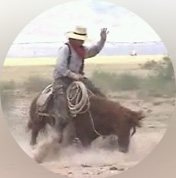 Bob Kinford is a life long working cowboy, horseman, reduced stress cattle handling expert, humorist, and the producer of the Texas Crossroads Cowboy Gathering; the only cowboy entertainment talent show. He’s also the owner of the 2lazy4U Livestock & Literary Company in the El Paso, Texas Area and a great writer.
Bob Kinford is a life long working cowboy, horseman, reduced stress cattle handling expert, humorist, and the producer of the Texas Crossroads Cowboy Gathering; the only cowboy entertainment talent show. He’s also the owner of the 2lazy4U Livestock & Literary Company in the El Paso, Texas Area and a great writer.
____________________________________________________________________________________________________________
One place where people seem to make mistakes is when they are watching the gate while someone else is pulling cattle. The most common mistake is when a cow is coming down the fence and breaks across the pen. It seems the reaction is to try and outrun the cow to get in front of it and turn it back to the gate. Of course the reaction of the person pulling the cow is the same. The end result is similar to squeezing a greased marble between your thumb and index finger and the cow flies across the pen stirring up and putting stress on the other cattle. Of course the first mistake is behind why the cow broke across the pen in the first place.
When a cow is coming down the fence it is wanting to get around the rider pushing it. No matter how relaxed the cow appears, it is still looking for a hole to get around the rider. If the cow spots the person on the gate, it will react in relationship to where that person is even if the cow is at the back of the pen and the person is just a few feet from the front of the pen. While some cows keep their heads down and never notice the rider watching the gate, others will pack their heads higher, notice the second rider, and react to go around them. I’ve worked with people who have a tendency to do things while watching the gate which will make a cow blow back across the pen. Of course these people are also constantly cursing these “crazy” cows without even giving a second thought to the fact that it may have more to do with what they are doing than the cow‘s attitude.
The fact is, that ninety percent (or more) of the time, when a cow begins turning back or blowing back across the pen, the fault lies in something either the gate person or the person bringing the cow is doing. Other than letting extra cattle run out the gate, the person watching the gate needs to do several things. The most obvious is to recognize which cow the person is pulling. This is difficult if the person bringing the cow has several extra cows (or perhaps half the pen) with the one they want. The second thing is not so obvious. It is possible to attract the cow’s attention and begin moving ourselves in a way to help the person pulling it to get it to the gate. Often this can be done from quite a distance, sometimes from halfway across the pen.
Begin by moving your horse to turn the group of cows away from the gate while keeping your focus on the cow to be pulled. When the cow to be pulled begins to turn with the other cows use a little lateral movement to stop or slow down the action. You need to be careful with this as you don’t want to accidentally turn the cow back, but to keep it from going with the other cows and head for the gate. When you make the move to do this, the cow’s attention will be divided between you and the person pulling the cow. By using lateral movement and moving away from the cow, combined with the pressure from the person pulling the cow, the cow will turn and go past you towards the gate. As the cow goes past you, turn and go with it, using lateral movement to allow the cow to turn and see the gate.
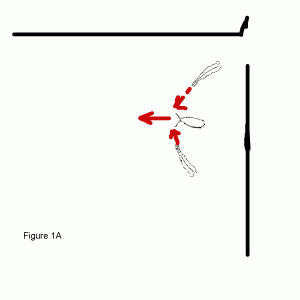 Of course there are those times when the gate is wide open, the cow has a clear field of vision to it, yet blows across the pen. When this happens the reaction of both the person pulling the cow, and the gate person is to get ahead of the cow to turn it. Of course this seldom works and we soon have the majority of the cows in the pen running around. The reason it doesn’t work is because, from the cow’s perspective, we are actually asking the cow to speed up, go by the gate person and across the pen as in figure 1A.
Of course there are those times when the gate is wide open, the cow has a clear field of vision to it, yet blows across the pen. When this happens the reaction of both the person pulling the cow, and the gate person is to get ahead of the cow to turn it. Of course this seldom works and we soon have the majority of the cows in the pen running around. The reason it doesn’t work is because, from the cow’s perspective, we are actually asking the cow to speed up, go by the gate person and across the pen as in figure 1A.
We must remember that our actions play a big part in how the cow reacts. We must also realize that we have been inundated through the years with being taught to work cattle against their natural instincts. As such we are working against ourselves and making our job more difficult. In order to change our reactions to the cattle, we need to concentrate more on reading the cattle and moving in a way which will cause them to react in the way we want. To be successful, this means making smaller adjustments and making them more often than we are used to. While we are making the transition (or when working with someone who doesn’t understand the concepts of working with the cattle), there will be times when we do need to move in a hurry. But we can do this in a way which will still keep the cattle a little calmer.
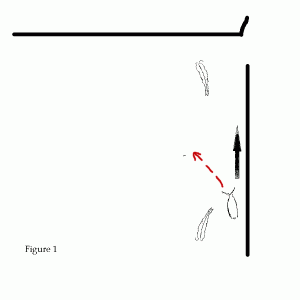 In Figure 1 the cow is being pushed a little to hard, spots the rider at the gate and runs across the pen. The person watching the gate could have prevented this by moving across the pen before the cow made its move. Once the cow has started moving fast across the pen it is usually too late to get in front of the cow. Trying to get in front of the cow at this point will only speed the cow up as in Figure 1 to the right.
In Figure 1 the cow is being pushed a little to hard, spots the rider at the gate and runs across the pen. The person watching the gate could have prevented this by moving across the pen before the cow made its move. Once the cow has started moving fast across the pen it is usually too late to get in front of the cow. Trying to get in front of the cow at this point will only speed the cow up as in Figure 1 to the right.
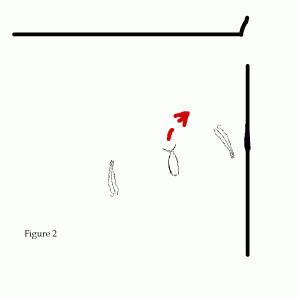 In order to turn the cow without adding more stress, the person on the gate needs to move up the fence while the person pulling the cow needs to use lateral movement, fading away from the cow as in Figure 2. As the “gate person” passes the cow’s hip, the cow will be drawn to look at them, taking the cow’s focus off the person pulling them for a second or two. However, the success in getting the cow to draw to the gate person is highly dependant upon what your partner is doing. The harder they are pushing the cow, the less the cow will be drawn to the gate person. Conversely, the more the person pulling the cow fades and removes pressure, the more the cow will be drawn to the gate person, changing its direction of travel.
In order to turn the cow without adding more stress, the person on the gate needs to move up the fence while the person pulling the cow needs to use lateral movement, fading away from the cow as in Figure 2. As the “gate person” passes the cow’s hip, the cow will be drawn to look at them, taking the cow’s focus off the person pulling them for a second or two. However, the success in getting the cow to draw to the gate person is highly dependant upon what your partner is doing. The harder they are pushing the cow, the less the cow will be drawn to the gate person. Conversely, the more the person pulling the cow fades and removes pressure, the more the cow will be drawn to the gate person, changing its direction of travel.
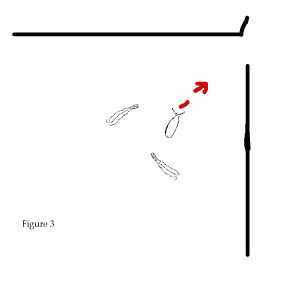 Once the cow is facing the gate as in Figure 3, its normal reaction will be to try and go around the gate person.
Once the cow is facing the gate as in Figure 3, its normal reaction will be to try and go around the gate person.
As your horse is bent into the cow and ready to turn, adjust yourself to the position shown in Figure 4. At this point, being flanked by both riders the cow will have the gate directly in front of it and should go right out the gate. I say should because even though the cow’s focus should be on the gate at this point, many people have the habit of hollering at the cow to speed it up. This habit of making noise to speed up a cow, or to get it going after it stops is another one of those things we have been taught to do which just causes us more problems than it solves. Noises such as shouting or slapping reins on our chaps, etc., just puts stress on the cow without having any focused pressure. As a result the cow is likely to go in a direction we don’t want it to go. Often when we approach a gate and start hollering or making noise to get the cow to go, it will turn to look at what is causing the noise, and try running back between the rider and the fence rather than out the gate. About the only time it is advisable to holler at a cow is when it is blind and can’t see what you are doing.
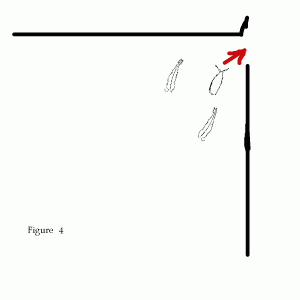 If the cow is wanting to turn back at the gate, rather than hollering at the cow as it approaches the gate, or putting more pressure on it, you can often speed a cow up by stopping and backing up your horse a few steps. This works because by backing your horses up, you are taking away any hole the cow thought it saw. As the cow is wanting to get away from you, and you have taken away the hole it wanted to use, it will go out the gate. This method will also work when you are walking a cow down the fence. If it stops (and especially when the cow looks back at you) you are too close. Rather than asking the cow to keep going forward you have positioned yourself so that the cow is thinking of going around you. By stopping and backing a couple of steps you are relieving the excess pressure and allowing the cow to move forward down the fence.
If the cow is wanting to turn back at the gate, rather than hollering at the cow as it approaches the gate, or putting more pressure on it, you can often speed a cow up by stopping and backing up your horse a few steps. This works because by backing your horses up, you are taking away any hole the cow thought it saw. As the cow is wanting to get away from you, and you have taken away the hole it wanted to use, it will go out the gate. This method will also work when you are walking a cow down the fence. If it stops (and especially when the cow looks back at you) you are too close. Rather than asking the cow to keep going forward you have positioned yourself so that the cow is thinking of going around you. By stopping and backing a couple of steps you are relieving the excess pressure and allowing the cow to move forward down the fence.
You can get more information Bob’s website “Natural Cattle Handling” by clicking HERE.

Bob, I thank, commend and applaud you for working toward the best treatment of cattle. I know nothing about working a large herd of cattle. We have a horse farm in northern Indiana and I have 3 tame Red Angus cows that I raise family beef from. It gets harder and harder for me to send the youngsters off, but I feel like Temple Grandin, the grand lady who has worked hard for humane treatment of our meat animals, that the final result isn’t to become vegetarians necessairly, but to treat our meat animals with kindness, dignity and a humane end to their lives. I feel it is God’s given duty to us humans that we treat all animal creatures with consideration, especially those who are going to die for us. I have written a book about my life with Tennessee Walking Horses who are subjected to a training method called “soring” which is the application of a chemical or mechanical agent applied to their lower leg or hoof, which causes pain to enhance movement for show purposes. This is outlawed by the government, but still prevails. My book is my effort to stop this abuse http://www.rosemiller.net
So, thanks again for what you do to help the animals!